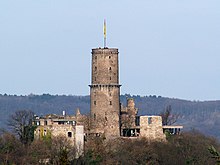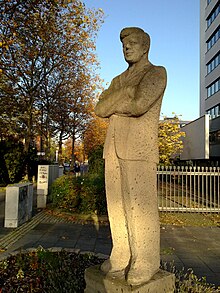Female tuff
| Female tuff | |
|---|---|
| Main features | |
| group | Volcanite |
| Subgroup | Leucite - Phonolite -Tuff |
| Occurrence | Germany, Rhineland-Palatinate, Weibern |
| colour | light gray to ocher |
| use | Stone, facade cladding, floor coverings, window sills
|
| Trade names | Eiffeltuff |
| Dismantling situation | active breakdown |
| Division into hard and soft stone | Soft rock |
| Age | quaternary |
| Reference example | Cologne City Hall , Koblenz City Hall |
| Special marks | numerous inclusions from rock fragments |
Weiberner Tuff is in the Eifel near the village women near Mayen in Rhineland-Palatinate in quarries broken. In this deposit there is a particularly fine-grained layer called the flute stone . This natural stone, a phonolite rock , was created in the Quaternary from volcanic activity.
geology
The Vulkaneifel is divided into the Hocheifel , West and East Eifel . The oldest volcanic eruptions took place around 45 to 24 million years ago in the Hocheifel. In the West Eifel, volcanism began again 700,000 years ago with the formation of cinder cones and maars .
Volcanic activity began in the Eastern Eifel 500,000 years ago. 450,000 to 350,000 years ago, huge amounts of pumice and volcanic ash were emitted in the Rieden area , creating several tuffs, including the Weiberner tuff.
The last major volcanic eruption took place in the Eifel around 13,000 years ago at Lake Laacher . After that there was only one minor eruption that led to the formation of the Ulmener Maar 11,000 years ago .
Rock description
This light brown to ocher colored volcanic tuff is a natural stone from the Eastern Eifel . Weiberner tuff is fine to large-grained and is also referred to as selbergite tuff , a local name, or leucite-phonolite tuff by geologists . In those of solidified volcanic ash are existing rocks phenocrysts of rock fragments which reach a size of up to 12 millimeters. The texture of this rock is directionless and spongy.
A rock layer of the deposit consists of particularly small mineral grains of up to 1 mm. This fine-grained rock layer is known as the flute stone, which is particularly suitable for stone carving. However, it is not frost-resistant. The term flute stone probably comes from the stonemasons , as this tuff gives off a particularly bright sound during sound testing, a quality check, and when manually working.
Sometimes this stone was also used as oven stone .
Mineral inventory
Weiberner tuff has a microcrystalline base mass of 71 percent ( microcline , biotite , leucite , titanite , olivine , nepheline , analcime , augite , glass and microlites (smallest components)) and 21 percent inclusions ( sandstone , slate , pumice , titaniumugite , sanidine , carbonate , Hornblende , nepheline, glass and opaque components).
use
Weiberner tuff was used for solid buildings as brick, wall cladding, window and door cornices, tombs and for stone carving . It was used for houses around Weibern and at Koblenz Town Hall . The Xanten cathedral , the church of Welcherath and the Godesburg near Bonn are made of this tuff. He was also trained at the RWTH Aachen and FH Aachen , at the Cologne City Hall , the St. Rochus Church and the State House in Düsseldorf, the Bernardus Church in Frankfurt am Main , the C&A building in Dortmund and the St. Laurentius Church in Remagen- Oberwinter built . At Aachen Cathedral , a large part of the window frames of the Carolingian octagon , which were newly installed in the 19th century, consist of this tuff rock. Furthermore, the buildings of the Hamburg Landungsbrücken are made of Weiberner tuff. Another example of the use of the building material is the soldiers' memorial on Johannisberg in Bad Nauheim .
The Weiberner tuff is very soft and easy to work with. Its weathering behavior can be described as good, soft components easily smell out.
Distinction
In the regional tuff extraction area in the Eifel there are several types of rock, the Riedener tuff , the Ettringer tuff and the Römertuff. It can be difficult to differentiate. The Riedener tuff can be recognized by its green color, the Ettringer tuff can have fragments up to 10 cm in size and is harder than the Weiberner tuff. The Römertuff is colored gray-brown.
Others
In Weibern there is a stone carving association that has rebuilt a stonecutter from the 1950s and is developing activities in connection with the regional tuff.
literature
- Wolf-Dieter Grimm: picture atlas of important monument rocks of the Federal Republic of Germany. ed. from the Bavarian State Office for Monument Preservation. Lipp-Verlag, Munich 1990, ISBN 3-87490-535-7 .
- Karlfried Fuchs: Natural stones from all over the world: discover, determine, apply. (= Callwey stone index ). Volume 2, Callwey-Verlag, Munich 1997, ISBN 3-7667-1267-5 , p. 247f.
Web links
- Anton Bermel: Our tuff. Retrieved September 19, 2009.
Individual evidence
- ↑ Hans-Ulrich Schmincke: Vulcanism . Scientific Book Society, Darmstadt 2000, ISBN 3-534-17471-2 .
- ↑ a b c Wolf-Dieter Grimm: picture atlas of important memorial stones of the Federal Republic of Germany. 1990, p. 169.
- ^ Friedrich Müller: Vulkanischer Tuff: Weiberner Tuff. Building information from the IRB library. ( baufachinformation.de ( memento from July 30, 2012 in the web archive archive.today ) accessed on September 20, 2009)
- ^ Website of the Steinhauerverein Weibern accessed on September 19, 2009.
Coordinates: 50 ° 24 ′ 46.5 ″ N , 7 ° 9 ′ 11.9 ″ E





